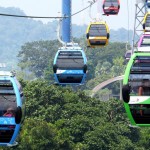NEPAL > Cable Car as an Urban Form of Transportation in Kathmandu ?
 My Republica published the article titled “Baudha to Tahachal in 30 minutes by cable car!” outlining a feasibility study done to address the need for a supplemental form of public transportation in Kathmandu.
My Republica published the article titled “Baudha to Tahachal in 30 minutes by cable car!” outlining a feasibility study done to address the need for a supplemental form of public transportation in Kathmandu.
It further writes:
“One can go from Baudha to Tahachal in 30 minutes by cable car and at a reasonable fare, according to a feasibility study. The estimated fair one way would be about Rs 40 at current prices and it will take just half the time as by public bus or private vehicle. ”
If implemented, it can act as an effective transportation infrastructure to promote tourism as travelers can enjoy the mountainous scenery surrounding the Kathmandu valley (assuming of course less pollution and higher visibility) and as it connects various landmarks. It’s dubious whether this cable car system can act as a mode of mass transit system for locals though, as Kathmandu is quickly turning into a dense metropolis, and cable car by design have limited capability. Nonetheless, it definitely has the potential to act something like the trolly cable car system in San Franscisco, which is mobilized more by tourists and less by daily commuters and yet adds to that charm that defines the city.
Below is rest of the write up directly quoted from MyRepublica:
The system can be divided into three phases for its development, according to the study.
The estimated cost of the project is Euro 112 million (approximately Rs 13.55 billion) and the detailed financial viability will be worked out in another report which is likely to be completed by the next six months.
The feasibility study has identified three other routes also — Lagankhel to Jamal, Tankeshwar to Gangabu Bus Park, Kalanki to Ratnapark– for cable cars in Kathmandu. More detailed study for these routes is yet to be done. Two french consultants, SYSTRA and MDP, are involved in the study.
French ambassador to Nepal Yves Carmona handed over the feasibility study report to Secretary at the Ministry of Physical Infrastructure and Transport (MoPIT) Arjun Karki amid a function held at the ministry on Monday.
MoPIT gave permission to the consultants in February last year for carrying out the study.




